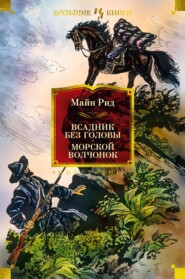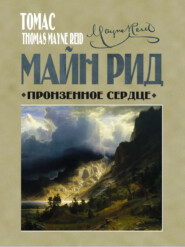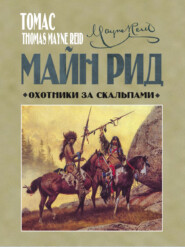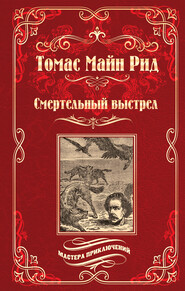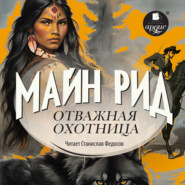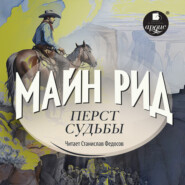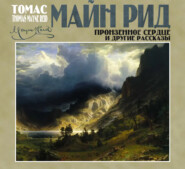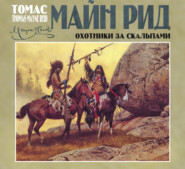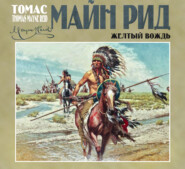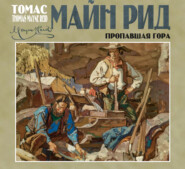По всем вопросам обращайтесь на: info@litportal.ru
(©) 2003-2025.
✖
The Young Yagers: A Narrative of Hunting Adventures in Southern Africa
Настройки чтения
Размер шрифта
Высота строк
Поля
He now remembered that, while battling about below, he had noticed a dark spot above the ledge, which he had conjectured to be the entrance of a cave, or a hole in the cliff. He had thought of it once again, but as creeping within a cave would not render him more secure than he was out on the rock, he had not gone towards it.
Now it occurred to him that he might examine the cave, and enter it if large enough to admit him. It would, at least, be pleasanter there, as he would be sheltered from the hot rays of the sun – an important consideration at that moment.
But there was another consideration that influenced him still more; and that was, the thought that were he once out of sight the rhinoceros might forget him. He knew that the old adage, “out of sight, out of mind,” had a good deal of meaning when applied to the borelé, the lion, and many other dangerous animals; and perhaps the proverb would also hold good of the keitloa – though what he had heard of this creature gave him very little ground to hope. At all events, he could test the thing. It would not cost much time to make the trial; and even should it prove of no service in that way, the change from his present stand upon the hot ledge for a seat within a cool cavern could not otherwise than better his condition. To the cave then!
Fixing his eye upon the keitloa, he commenced moving along the terrace, towards the point where he remembered having noticed the dark fissure in the cliff.
The keitloa followed, keeping with him step for step; and apparently roused to fresh vigilance, as if it feared that its victim was about to attempt an escape. All the way it followed him; and as the ledge grew narrower, it became necessary for Hendrik to proceed with great caution. Not that he was in danger of falling from it, but rather of being dragged– for the rhinoceros, by standing on his hind-legs, was now able to stretch his broad muzzle above the edge of the rock, and to protrude his elastic snout across the ledge within a few inches of the wall beyond. It therefore required “gingerly” stepping on the part of Hendrik. Notwithstanding all the menacing efforts of his adversary, Hendrik succeeded in reaching the entrance of the cave.
It was a cavern deep and dark, with a mouth sufficiently large to admit the body of a man in a bent position.
Hendrik was about stooping to enter it, when a loud “purr” sounded in his ears that caused him to start erect again, as if some one had run a needle into his back! The “purr” was quickly followed by a “roar,” so deep and terrible, that in his first moments of alarm, the hunter felt half inclined to leap to the ground, and risk the horns of the rhinoceros, which, at that instant, were gleaming above the ledge, within twenty inches of his feet!
There was no mystery in what caused the alarm. There was no mistaking that roar for any other earthly sound. The cave was tenanted by a lion!
The tenant did not remain much longer within his house. The roaring continued; and every moment sounded nearer and clearer. The huge claws caused a rattling among the dry pebbles that strewed the bottom of the cave. The lion was coming forth!
With the nimbleness of a klipspringer, Hendrik bounded to one side, and ran back along the ledge, looking fearfully behind him.
This time he was not followed by the keitloa. The rhinoceros, whether terrified by the roar of the lion, or whether his attention was solely taken up by it, remained standing where he had taken up his position, with his head projected over the rock, and his snout pointed towards the entrance of the cavern.
Next moment the shaggy front of the lion filled the mouth of the cave, and the king of beasts and the “king of brutes” came face to face!
For some moments they remained gazing at each other; but the eyes of the lion seemed to intimidate the keitloa, and the latter drew his head back, and dropped on all fours to the ground. Perhaps he would have gone off from the spot without an encounter; but the ire of the dread monarch had been aroused by this intrusion upon his rest. For a moment he stood lashing his tawny sides with his tail; and then, crouching until his breast touched the rock, he launched himself out from the ledge, and came down with all the weight of his body upon the broad back of the keitloa!
But, king as he was, he had mistaken the character of that “subject,” if he thought he was going either to mangle him badly, or put him to flight. Sharp as were his claws, and strong his arms to strike, they barely scratched the thick hard hide of the pachyderm; and although he tried to “fix” himself on the shoulders of the latter, he could not manage to stick. Had it been a buffalo, or an antelope, or even the tall giraffe, he would have ridden it to death; but to ride a rhinoceros was a different affair; and he found it so. Although he used both teeth and claws to keep him in the position he had taken, neither would serve him, and he was dismounted almost in an instant. The moment the keitloa felt the fierce rider on its back, it made a desperate rush outward from the rocks, and shaking its huge body like an earthquake, it cast the lion to the plain.
The lion crouched as if again to spring; but the latter, suddenly turning upon his antagonist, stood face to face with him before he could effect his purpose.
The rhinoceros did not pause a moment, but rushed on his antagonist with his horns set like couched lances. The weight of his body, with the impetuosity of the charge, would have driven those hard sharp weapons through the toughest skin that lion ever wore, and through his ribs as well. The lion seemed to be troubled with some such idea; for, instead of awaiting the onset of his enemy, he turned tail – the cowardly brute! – and made off up the pass, the keitloa chasing him as if he had been a cat!
Hendrik, all the while, had watched the combat from the ledge; but he never knew how it ended, or whether the rhinoceros overtook the lion or not. The moment he saw the two great brutes in full run up the pass, he leaped from the ledge and ran down it, with all the speed he could take out of his legs.
On reaching the angle, he hesitated a moment which way to take – whether to follow back the spoor of the hunt, or the later tracks of his horse – but at length he decided on following back his own spoor over the open plain. He ran along it as fast as he was able, looking over his shoulders at very short intervals, and still fearful that the great black body would show itself in his rear. He was agreeably disappointed, however. No keitloa followed in pursuit; and soon another agreeable fact came under his notice – he perceived that his horse had also gone back the same way. On rounding a clump of bushes some distance farther on, he saw the horse browsing a little way off upon the plain.
The latter permitted himself to be caught; and Hendrik, once more mounting to the saddle, pursued his way towards the camp. The spoor of the hunt guided him in a direct line; for the blesboks, it will be remembered, ran all the while to windward, thus following a straight course. Hendrik had no difficulty in following the track; and, after two hours’ riding, got back to camp, having picked up most of the dogs on his way back.
Hans and Arend did laugh at him. Groot Willem did not. The latter remembered how his rival had acted after his own tumble over the burrow of the aard-wolf; and now reciprocated Hendrik’s handsome behaviour on that occasion. Groot Willem and Hendrik were likely to become great friends.
Chapter Thirty Two.
A Vast Herd of Antelopes
Next day the young yägers were witnesses to a most extraordinary spectacle; and that was, a vast herd of blesboks, – so vast, that the plains appeared literally covered with their purple masses!
This herd was not browsing, nor at rest, but scouring up against the wind – as those hunted the day before had done – and evidently running as if some dreaded enemy in their rear had given them an alarm.
The mass of bodies was nearly half a mile in width; but it would have been difficult to estimate its length, as it continued to pass before the eyes of the yägers for more than an hour! On the animals poured, sometimes running in line, and sometimes the hindmost leaping over those that preceded them, moving like an impetuous torrent. All of them ran with necks extended forward, their noses close to the ground, like hounds running upon the scent!
Here and there they were closely packed in dense masses, while in the intervals between, the bucks were thinly interspersed; and now and then were wide breaks, like an army marching in column.
The cause of these openings was simply that the immense drove consisted of a great many separate herds, all running by one impulse; for it is a curious habit of the blesboks and bonteboks, that when one herd becomes alarmed, all the other herds that chance to be in the same plains with this one, both to windward and leeward of it, start off in succession; and as all, from their habit of running up the wind, must follow the same direction, a constant drove, or rather a continuous succession of droves is formed, and passes in open column before the spectator who may be on either flank. The wonderful spectacle of so many living creatures, running together in such countless numbers, brought to mind the accounts, which the young yägers had read, of the migrations of the buffalo on the prairies of America, and also those of the passenger-pigeon. Of course, the resemblance to the “trek-boken” of their own springboks, which all of them had witnessed, was also remembered.
On this day our hunters were more successful than upon the preceding. They had learnt by their experience of yesterday how to “jäg” the blesbok.
Instead of attempting either to “stalk” or “head” them, they found that the best plan was to ride along the flanks of the running herd, and now and again dash near enough to fire into the thick of them. The blesboks, while moving to windward, will permit the hunter to get within three or four hundred yards of their flank; and the mounted hunter, keeping his horse fresh, can now and then gallop within shooting distance before the moving mass can turn out of its course. Firing among a flock in this aimless way, the bullet is not always sure of a victim, but now and then a buck fells to the shot.
Practising this plan, the young yägers played upon the flanks of the great herd during the whole time of its flight to windward; but notwithstanding the continuous cracking of rifles, with now and then the louder detonation of Groot Willem’s great elephant-gun, the slaughter was not very great. Six only “bit the dust.” But as in the six there chanced to be an equal number of bucks and does, the hunters were quite content. They were not “jäging” for the meat, but merely to get specimens of the horns and prettily-painted skins; and three of each were as many as they wanted.
The hunt was soon over; and as their horses were pretty well “blown,” the yägers returned at an early hour to camp, taking with them only the heads, horns, and skins of their game, with just enough of the venison to give them fresh steaks for a day or two.
One peculiarity they remarked in skinning the blesboks – that the skins of these beautiful creatures exhaled a pleasant perfume – arising, no doubt, from the fragrant plants and herbage upon which the animals feed.
The afternoon was spent in dressing the skins – by removing the fatty flesh that adheres to them – and they were then spread out to dry. Under such a hot sun, a few hours was sufficient to render them dry enough to be carried on to the next camp, where they would be spread out for a longer period, and thoroughly prepared for packing in the wagons.
Hendrik and Groot Willem performed this service; but the preparing of the heads – a more scientific operation – was the work of Hans assisted by Arend. Hans had his box of chemicals, consisting of arsenical soap and several other noted “preservers,” which he had brought along for this special purpose; and by night, two pairs of heads, with the skin and horns attached, were thoroughly cleaned and mounted, and ready for nailing up to the wall.
There was a buck and doe in each pair; one, of course, for the Von Blooms, and another for the mansion of the Van Wyks.
The only difference between the horns of the blaze-buck and the blaze-doe is, that those of the latter are shorter, and more slender; while the skin of the doe is less vivid in its colouring, and smaller, as is also the body of the animal. The same remark applies to the kindred species – the bonteboks – of which brilliantly coloured creatures full sets of horns and skins were obtained the day after.
On this occasion, the “stand and drive” recommended by Groot Willem had been tried again, and with great success; each of the four – Hans, Hendrik, Arend, and Groot himself – having shot his buck as the flock dashed up to their stands. Indeed, Hans, upon this occasion, had carried off the palm. His double-barrel, loaded with ball, had enabled him to knock over a couple of the “painted goats” – as bonteboks are sometimes styled – right and left.
The explanation of their success in this hunt, and their failure when trying the same plan with the blesboks, is not found in any essential difference between the two species. Their habits are almost the same.
No. Their success lay simply in the fact, that on the day when they jäged the bontebok, there was no wind – not a breath of air stirring. On this account the game were not only unable to run against the wind, but, keen as is their scent, they were not able to tell behind which ant-hill lay their concealed enemies.
The consequence was, that Klaas and Jan were able to drive them right up to the ambushed hunters, who slew them without difficulty.
The “stalk” would not have succeeded on such a day, for these antelopes trust far more to their nose than their eyes; moreover, a correct rifle-shot is very difficult to be obtained in the plains of the “zuur-veldt,” – as the mirage is almost always upon them, and interferes with the aim. So strong is this mirage, that objects at a distance become quite distorted to the eye, and out of all proportion. A secretary bird stalking along looks as big as a man, and an ostrich attains the altitude of a church-steeple. Even the colour of objects becomes changed; and travellers have mistaken a pair of tawny lions for the white tilts of their own wagons and have gone towards them, thinking they were riding into their camp! An awkward mistake, I should fancy.
After having secured their specimens of the pied antelopes, the young yägers again broke up camp, and treked away across the plains of the “zuur-veldt.”
Chapter Thirty Three.
The Lone Mountain
It has been observed, that upon the plains of the zuur-veldt country, mountains of singular forms meet the eye of the traveller – cones, domes, square box-like masses with table tops; sharp ridges, like the roofs of gigantic houses; and some that pierce the heavens with pointed peaks like the steeples of churches! Some, again, present a horizontal outline, like the parapet of a fortification, while square tower-like masses, rising above the general level, carry out the idea of some work of military architecture on a grand scale.
Our young yägers were very much interested in these mountain forms, so varied and fantastic. Sometimes their route led them along the base of a precipice rising a thousand feet sheer above the plain, and trending for miles without a break, so that for miles no access could be had to the mountain that rose still higher above. Sometimes they were compelled to trek along narrow ridges that sloped off on both sides, leaving scarce enough of level to run the wheels upon. Then, again, they would be compelled to pass around some spur, that, shooting for miles out into the plain, barred their direct path.
As they treked across one of the widest plains they had yet seen, a singularly formed mountain drew their attention. It could scarce be called a mountain, as its altitude above the plain could not have been more than seven or eight hundred feet; but its brown rocky surface gave it that character, and to have styled such a mass a hill would have been equally misnaming it. There were no “foothills,” or inequalities near its base. The greensward of the level plain stretched away on every side – its verdant colour strongly contrasting with the dark brown granite of the mountain.
The sides of this singular mountain sloped from base to summit as regularly as those of an Egyptian pyramid; and at a distance it looked pyramidal, but on coming nearer its rounded form could be perceived. It was, in reality, an obtuse cone, perfect in all except the apex, and it was there that the peculiarity of this mountain lay. Instead of ending at the apex, a steeple-like rock rose out of the summit some thirty feet higher, ending in a point that appeared from below as “sharp as a needle.” It was this that had drawn the attention of the young yägers more particularly, as other mountains of conical form were common enough along their route; but this one, looking, as one of them observed, like an inverted funnel, differed from any they had yet seen. It was very conspicuous, thus standing isolated in the midst of the open plain, and contrasting so much in its colour with the green table upon which it appeared to rest.
“Let us go and explore it,” proposed Arend; “it isn’t much out of our way. We can easily overtake these slow-going oxen again. What say ye all?”
“Let us go, by all means,” said Hans, who fancied that upon so odd-looking a mountain he might fall in with some new plant.






